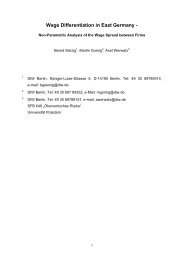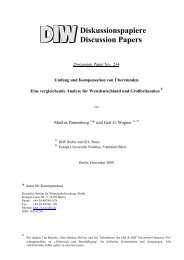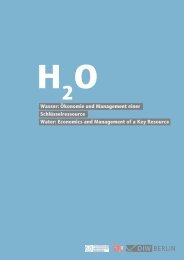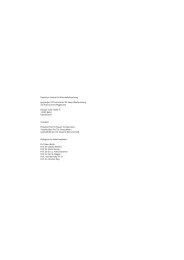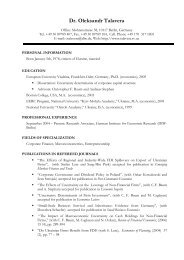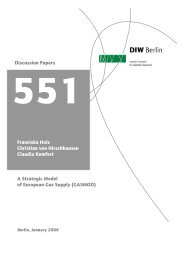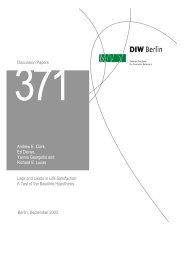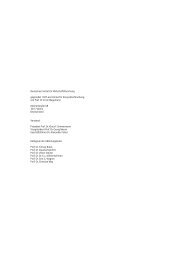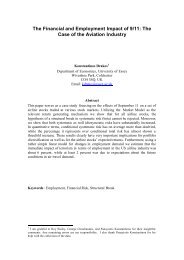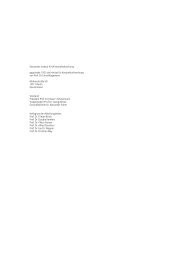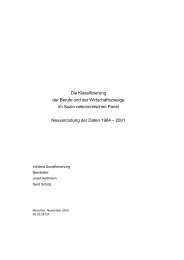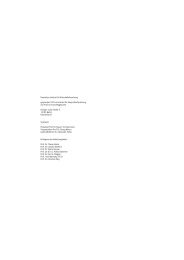Holger Görg and Frederic Warzynski Price cost margins ... - DIW Berlin
Holger Görg and Frederic Warzynski Price cost margins ... - DIW Berlin
Holger Görg and Frederic Warzynski Price cost margins ... - DIW Berlin
You also want an ePaper? Increase the reach of your titles
YUMPU automatically turns print PDFs into web optimized ePapers that Google loves.
4 Econometric Results<br />
As pointed out above, our analysis is based on firm level panel data for UK<br />
manufacturing industries. Since equations (3) to (6) are essentially twice<br />
differenced equations any possible firm specific unobservable effects that may<br />
impact on a firm’s production function are cancelled out. Hence we can use<br />
simple pooled regression techniques for the estimation. 8 We allow for heteroskedasticity<br />
of the error term, as well as an unspecified correlation between<br />
error terms within establishments, but not across establishments. This allows<br />
for the likely possibility that error terms within firms are correlated over<br />
time.<br />
4.1 Average price <strong>cost</strong> <strong>margins</strong><br />
We start with estimating equation (3) for the entire sample in order to provide<br />
a baseline of the average PCM in UK manufacturing firms. The results<br />
are reported in column (1) of Table 2. We report the coefficients of β it<br />
estimated from the regressions <strong>and</strong> the implied value of the mark-up µ it. The<br />
estimates of the Lerner index β it are statistically significantly different from<br />
zero, suggesting the existence of market power <strong>and</strong>, hence, deviations from<br />
perfect competition in UK manufacturing industries. The average mark-up<br />
is 1.12 which is well within the range of estimates provided by Small (1997)<br />
for a number of UK manufacturing industries.<br />
This estimation imposes the constraint that the average PCM is constant<br />
over time. In order to relax this assumption we constructed interaction terms<br />
of year dummies with ∆xit which are included in equation (3). Inclusion<br />
of the time interaction terms, i.e., allowing for changes in PCM over time in<br />
column (2) indicates a reduction in the average PCM for all years relative<br />
to 1990. While the focus of our paper is not on explaining the evolution of<br />
mark-ups over time, we note that this finding is in line with Griffith (2001)<br />
who argues that the European Single Market Programme, which became<br />
effectivein1992,ledtoanincreaseinproductmarketcompetitioninthe<br />
UK. Note that, in all specifications, we can reject the hypothesis that the<br />
interaction terms are jointly equal to zero. Hence the specification in column<br />
(2) should be preferred to column (1).<br />
8 We also replicated all estimations using a fixed effects estimator. In the majority of<br />
cases, a simple F test of the significance of the firm fixed effect rejects the specification,<br />
hence we prefer the pooled estimations as used here.<br />
10



